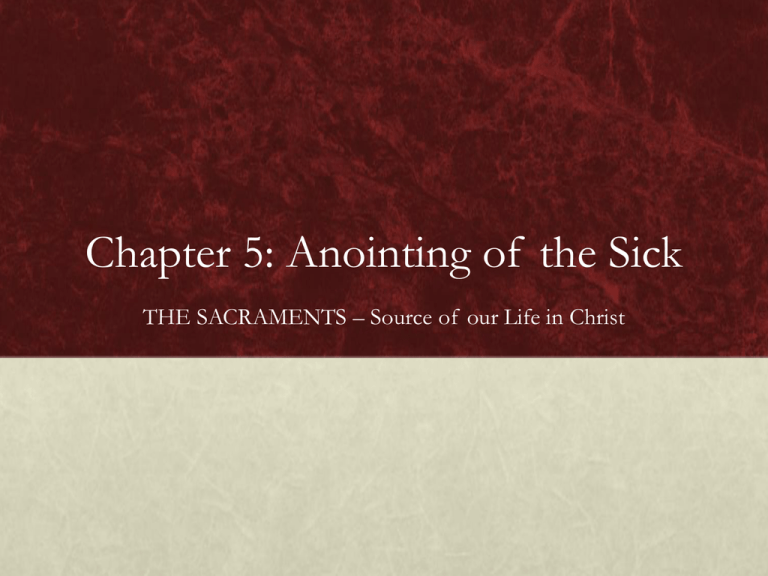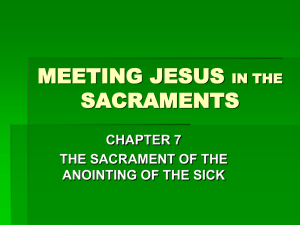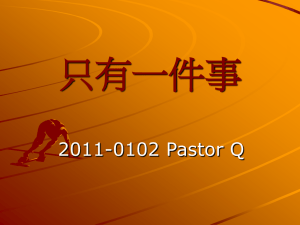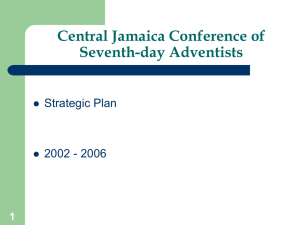Chapter 5: Anointing of the Sick
advertisement

Chapter 5: Anointing of the Sick THE SACRAMENTS – Source of our Life in Christ 1. Christ’s Ministry of Healing (pp. 132-135) Anticipatory Set Read Mt 9:1-8 Christ heals the paralytic’s body as a visible sign that he could heal the man’s soul by forgiving his sins. 1. Christ’s Ministry of Healing (pp. 132-135) BASIC QUESTIONS What was Christ’s ministry of healing? How has the Church continued Christ’s ministry of healing? KEY IDEAS Christ healed people from physical infirmity out of compassion and to show he was the Messiah. One of the major missions of the Church is the alleviation of human suffering, which she has faithfully carried out over the centuries. 1. Christ’s Ministry of Healing (pp. 132-135) How are the two Sacraments of Healing implicit in Christ’s healing of the paralytic man (Mt 9:1-8)? Christ forgave the man’s sins (Sacrament of Reconciliation) and healed him of his sickness (Sacrament of Anointing of the Sick). What are ways Christ showed his concern for the sick during his time on earth? He healed many who were ill, showed the meaning of suffering, gave his Apostles the power to heal, and he instituted the Sacrament of the Anointing of the Sick. What was one of the most powerful signs that showed that Christ passed his powers on to his Church after his Ascension? The Apostles effected many physical healings. 1. Christ’s Ministry of Healing (pp. 132-135) Guided Exercise Have the students complete the following table to organize their knowledge of how Christ helps us with the Sacraments during various stages of our life on earth. 1. Christ’s Ministry of Healing (pp. 132-135) 1. Christ’s Ministry of Healing (pp. 132-135) What were the two reasons Christ performed miracles of physical healing? To show compassion toward those who suffered and to demonstrate that he was the Messiah. In what sense is Christ the Divine Physician? Christ heals the whole man: the body through healing and the soul through forgiveness of sins. What does it mean that Christ “identifies himself ” with the sick (CCC 1503)? In his interpretation of the Parable of the Sheep and the Goats, Christ says that what we do for the sick, we do for Christ. 1. Christ’s Ministry of Healing (pp. 132-135) How has Christ’s concern for the sick been manifested in the life of his Church through the centuries? The Church considers the relief of human suffering as one of its primary missions. This is attested to by thousands of Catholic hospitals and by religious congregations and saints who have dedicated their lives to helping the sick. Is helping the sick and suffering only the responsibility of Christians specially called to it? No. It is every Christian’s responsibility. Is Anointing of the Sick only concerned with healing of the body? No. It is concerned with both the body and the soul. When is the Sacrament administered? It can be administered whenever a person is afflicted with serious sickness, reaches old age, or is facing death. 1. Christ’s Ministry of Healing (pp. 132-135) Guided Exercise There are thousands of contemporary Catholic efforts to help the sick and suffering. Visit the following website to learn about the Sisters of Hawthorne, who help destitute sufferers of incurable illnesses free of cost. http://www.hawthorne-dominicans.org/ 1. Christ’s Ministry of Healing (pp. 132-135) Who was Bernadette? A young girl to whom Our Lady appeared in 1858. What is the meaning of the healings of Lourdes and the name the “Lady” told Bernadette? With the healings and the name, “The Immaculate Conception,” Our Lady was confirming the title which the Church had given the Virgin Mary just four years earlier. What does the title “Immaculate Conception” mean? It means that Mary, the Mother of God, was preserved free from the stain of Original Sin from the moment of her conception. How many cures has the Church officially declared to be miraculous at Lourdes? At this time, sixty-seven. 1. Christ’s Ministry of Healing (pp. 132-135) Closure Write a paragraph summarizing Christ’s and his Church’s ministry of healing. 1. Christ’s Ministry of Healing (pp. 132-135) Homework Assignment Reading: Pp. 136-138. Questions: Questions: 1-2. Workbook: 1-11. Practical Exercise 2. 1. Christ’s Ministry of Healing (pp. 132-135) Alternative Assessment Class discussion on Practical Exercise 2, whether a terminally ill person should be told if he or she is dying. 2. Christ’s Healing Touch in the New Testament (pp. 136-138) Anticipatory Set Read John 9:1-39 as the class’s Opening Prayer. This is the account of Jesus’ dramatic healing of the man blind from birth, with the controversy it caused among some of the religious authorities in Jerusalem. 2. Christ’s Healing Touch in the New Testament (pp. 136-138) BASIC QUESTIONS Why did Jesus choose to heal through physical touch? How do we know Christ instituted the Anointing of the Sick? KEY IDEAS Jesus chose to heal through physical touch as a sacramental sign of spiritual healing and of the arrival of the Kingdom of God. Jesus associated his Apostles with his healing ministry and instituted the Anointing of the Sick as recorded in the Epistle of St. James. 2. Christ’s Healing Touch in the New Testament (pp. 136-138) What did Jesus ask from those who came seeking healing? Faith in him. What do the seven examples of physical healings Jesus performed have in common (pp. 136-137)? In each of them there is physical touch: either Jesus touches them or they touch him. What was Jesus’ ultimate concern for those he encountered? Their eternal salvation. Could Jesus have healed every person in Palestine―and even in the world? Yes. 2. Christ’s Healing Touch in the New Testament (pp. 136-138) Why didn’t Jesus heal everyone? His mission was not to remove all suffering from the world. He did want to give us the grace to accept suffering as a means of uniting ourselves with his Redemption. What was the eventual earthly fate of every person Jesus healed, even Lazarus? They all eventually died. What was the meaning of Jesus’ healings beyond their physical benefits to the person healed? They announced that the Kingdom of God had come with healing and victory over sin and death through Christ’s own Death on the Cross. 2. Christ’s Healing Touch in the New Testament (pp. 136-138) Guided Exercise Read the paragraph beginning, “From this small selection,” thinking about the following question: How are Jesus’ healings sacramental? 2. Christ’s Healing Touch in the New Testament (pp. 136-138) Guided Exercise Have the students complete the following table on the effects of Anointing of the Sick. 2. Christ’s Healing Touch in the New Testament (pp. 136-138) 2. Christ’s Healing Touch in the New Testament (pp. 136-138) How did Jesus associate his Apostles with his healing ministry before the Resurrection? Jesus instructed his Apostles to heal the sick, and they “anointed with oil many that were sick and healed them” (Mk 6:12). What did Christ promise the Apostles after the Resurrection? He promised if they laid their hands on the sick, the sick would recover. Where do we learn of how the early Church administered the Sacrament of the Anointing of the Sick? In the Epistle of St. James. 2. Christ’s Healing Touch in the New Testament (pp. 136-138) How was the Sacrament administered? The elders (presbyters in Greek, priests in English) were to pray over the sick person and to anoint him or her with oil in the name of the Lord. What are the effects of the Sacrament, according to St. James? The person will be physically healed and his sins will be forgiven. What is the matter of the Anointing of the Sick? Oil of the Sick, which is olive oil blessed by the bishop during the Chrism Mass on Holy Thursday. 2. Christ’s Healing Touch in the New Testament (pp. 136-138) Closure Write a paragraph summarizing the presence of the Sacrament of the Anointing of the Sick in the New Testament. 2. Christ’s Healing Touch in the New Testament (pp. 136-138) Homework Assignment Reading: Pp. 139-141, through “WHEN SHOULD THE SACRAMENT BE ADMINISTERED?” Questions: Questions: 3-8. Workbook: 12-20. Practical Exercise 1. 2. Christ’s Healing Touch in the New Testament (pp. 136-138) Alternative Assessment How can you participate in Christ’s healing ministry when passing by or visiting a hospital or medical clinic? 3. The Administration of the Sacrament of Anointing of the Sick (pp. 139-141) Anticipatory Set Every Sacrament has matter, form and a minister. Review for a few moments the matter, form, and minister of Baptism and the Eucharist. 3. The Administration of the Sacrament of Anointing of the Sick (pp. 139-141) BASIC QUESTIONS What is the matter, form, and minister of the Anointing of the Sick? What are the effects of the Anointing of the Sick? Who should receive the Anointing of the Sick? KEY IDEAS The matter of the Sacrament of the Anointing of the Sick is the Oil of the Sick, the form is the words the minister prays for the recipient, and the minister is a bishop or priest. The Sacrament prepares the recipient for death and eternal life and may restore health if it is good for the person’s soul. The Sacrament should be administered to anyone approaching or in danger of death, including one facing a serious operation or who has sustained a serious injury, and it may be repeated. 3. The Administration of the Sacrament of Anointing of the Sick (pp. 139-141) Guided Exercise Have the students visit the following website and do a search on the word “oil” in the Old and New Testaments. This will allow them to explore how important oil was in the ancient world and how it was used. http://quod.lib.umich.edu/r/rsv/simple.html. 3. The Administration of the Sacrament of Anointing of the Sick (pp. 139-141) What are the essential elements in the celebration of the Anointing of the Sick? Laying on of hands by the priest, prayer, and an anointing with holy oil. Why is it good to couple the Anointing of the Sick with the Sacraments of Reconciliation and the Eucharist? The recipient will receive graces. How was oil used in the ancient world as a medicine? Olive oil was used on wounds and on tired and aching muscles. What can be used as the matter of Anointing of the Sick in case of necessity? Any vegetable oil blessed by a priest. 3. The Administration of the Sacrament of Anointing of the Sick (pp. 139-141) What is the form of the Anointing of the Sick? The form is the prayer of the priest for ease of suffering, strength, freedom from sin, salvation, resurrection from the dead, and restoration of health to return to God’s service. Why is it good to have members of the faithful, especially the family, present at the Anointing of the Sick? Because every Sacrament is ecclesial and communal in nature. Who is the minister of the Sacrament of the Anointing of the Sick? Only a bishop or priest. 3. The Administration of the Sacrament of Anointing of the Sick (pp. 139-141) Guided Exercise Think/Pair/Share on the following question: Why is it appropriate that a priest is the minister of the Sacrament of the Anointing of the Sick? 3. The Administration of the Sacrament of Anointing of the Sick (pp. 139-141) THE EFFECTS OF THE ANOINTING OF THE SICK Think/Pair/Share on the following question: Why is a Sacrament like the Anointing of the Sick necessary for those who are facing death? 3. The Administration of the Sacrament of Anointing of the Sick (pp. 139-141) Closure Write a paragraph summarizing the matter, form, and minister of the Sacrament of the Anointing of the Sick. 3. The Administration of the Sacrament of Anointing of the Sick (pp. 139-141) Homework Assignment Reading: Pp. 141-144. Questions: Questions: 9-22. Workbook: 21-33. 3. The Administration of the Sacrament of Anointing of the Sick (pp. 139-141) Alternative Assessment Write a short summary detailing when the Sacrament of the Anointing of the Sick should be administered. 4. The Meaning of Human Suffering (pp. 141-144) Anticipatory Set Read Luke 10:30-35, Jesus’ narration of the Parable of the Good Samaritan. 4. The Meaning of Human Suffering (pp. 141-144) BASIC QUESTIONS What is the meaning of human suffering? What should our attitude be toward those who suffer? KEY IDEAS Human suffering is a mystery connected with sin. Christ suffered to redeem us and has linked all suffering with redemption. One can find joy in suffering. Christians are called to serve those in need, alleviating their suffering. Those who serve the suffering serve Christ. 4. The Meaning of Human Suffering (pp. 141-144) When should the Anointing of the Sick be administered? When a baptized Catholic is facing death. Also, when one reaches old age or is noticeably weakened in old age, or at any age when one is facing a serious operation, or when one has a serious illness or injury. Can this Sacrament be repeated? Yes, if one recovers and then falls ill again, or if the initial condition grows worse. Under what circumstance does the Anointing of the Sick forgive mortal sins? When the person is unable to make a Confession, but has or had the proper dispositions to make a good Confession. 4. The Meaning of Human Suffering (pp. 141-144) Should a dead person be given the Anointing of the Sick? No. The priest should pray for the soul of that person. How did Christ accomplish our redemption? Through his suffering. What did Christ do to suffering? He made all suffering potentially redemptive. How did suffering and death enter the world, according to Genesis? They entered as a result of Original Sin. 4. The Meaning of Human Suffering (pp. 141-144) What is the connection between suffering and sin? We know by experience that sin causes suffering but we should not assume that any particular suffering is the result of anyone’s particular sin. What does the Book of Job teach about suffering? Even the most upright and just person can experience suffering in his or her life. 4. The Meaning of Human Suffering (pp. 141-144) Guided Exercise Think/Pair/Share on the three paragraphs beginning, “Here we have no greater inspiration” (p. 142) using the following question: What is the redemptive meaning of suffering that Christ taught? 4. The Meaning of Human Suffering (pp. 141-144) Guided Exercise Perform a paragraph shrink on the excerpt from Spe salvi (beginning, “It is when we attempt”). 4. The Meaning of Human Suffering (pp. 141-144) Guided Exercise Have a class discussion on why it is difficult to help those who are suffering. 4. The Meaning of Human Suffering (pp. 141-144) Guided Exercise Read the sidebar, “Bl. Mother Teresa of Calcutta” and then write briefly on the one thing that most surprised you about the story of Bl. Mother Teresa. 4. The Meaning of Human Suffering (pp. 141-144) What meaning did Cardinal Bernardin find in Matthew 11:12-30? When he was suffering from terminal cancer, he found rest in the “yoke” of illness that Christ had sent him. What are the three Sacraments that initiate life and the three Sacraments that bring life to a close? Baptism, Confirmation, and the Eucharist initiate Christian life. Reconciliation, Anointing of the Sick, and the Eucharist prepare us for the next life. 4. The Meaning of Human Suffering (pp. 141-144) Closure Write a paragraph on the Christian meaning of suffering, including the call to serve those in distressing circumstances. 4. The Meaning of Human Suffering (pp. 141-144) Homework Assignment Reading: Pp. 145. Questions: Questions: 23-25. Workbook: 34-40. Practical Exercises 3 & 4. 4. The Meaning of Human Suffering (pp. 141-144) Alternative Assessment Work with a partner to consider the following scenario: A parish priest is called to the hospital at the request of a family. Their father, who up until that time seemed reasonably healthy, had lost consciousness in the home. After arriving at the hospital and speaking with the family, who were gathered around the hospital bed, the priest prepares to celebrate the Sacrament of Anointing. Should the family leave the room while their father is receiving the Sacrament of Anointing? If their father later dies, does that mean that the Sacrament of the Anointing was ineffective? What graces, seen and unseen, may result from the celebration of the Sacrament? THE END









